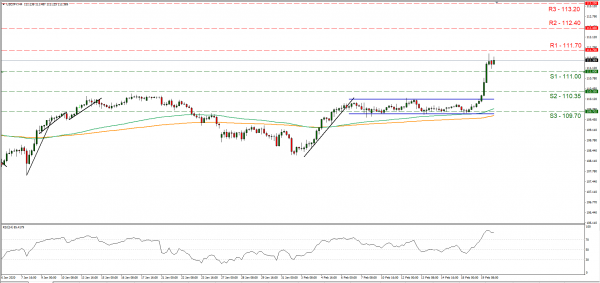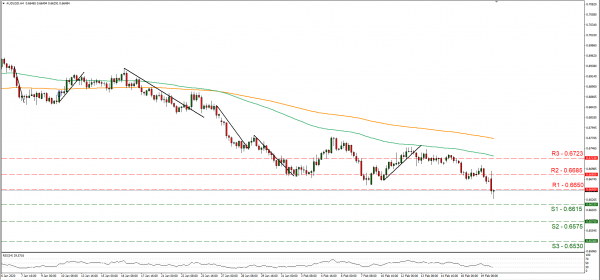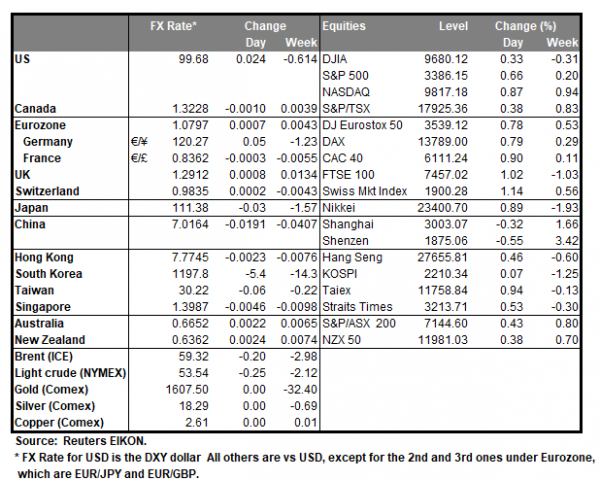JPY weakened against the USD yesterday, as worries about the novel coronavirus eased somewhat and a risk appetite was displayed in the markets. Increased expectations that China is to continue to take steps in order to reduce the possible economic impact of the coronavirus lifted the market sentiment. It should be noted that China proceeded with a rate cut of the benchmark loan prime rate in order to boost its economy this morning. Also, it should be mentioned that the growth in new Coronavirus cases seems to be slowing, boosting market confidence. Media report that factories in Mainland China are getting back online, however the situation still seems to remain tight. We expect that should the market sentiment continue to improve we could see safe havens weakening further. USD/JPY rallied yesterday reaching a 9 month high by breaking consecutively the 110.35 (S2) and the 111.00 (S1) resistance lines, now turned to support. As the pair broke the upper boundary of its past sideways movement, we switch our sideways bias in favour of a bullish outlook for the pair, albeit some correction could be in the cards for the pair, due to its steep upward slope. Please note that the RSI indicator below our 4 hour chart has clearly surpassed the reading of 70, confirming the bull’s dominance at the time, yet may also be implying a possibly overcrowded long position for the pair. Should the bulls maintain control over the pair, we could see it breaking the 111.70 (R1) resistance line and aim for the 112.40 (R2) resistance hurdle. On the other hand, should the bears take over, we could see the pair breaking the 111.00 (S1) support line and aim for the 110.35 (S2) support barrier.
AUD drops lower on weak employment data
The Aussie weakened against the USD, as January’s employment data showed a slack in the Australian employment market. The unemployment rate rose more than expected, while the employment change figure dropped, yet less than expected, causing the Aussie to weaken. The data increased market expectations for a possible rate cut as the RBA had placed special weight on employment trends to form its decisions. Also, analysts note that the weak Japanese data lately, may also have sounded the alarm for the Australian economy. Please note that the improvement of the market sentiment about the coronavirus as well as China’s efforts to deal with it, left the AUD largely unaffected. We could see AUD weakening further should market sentiment be guided by RBA expectations while positive news about the coronavirus could support it. AUD/USD dropped yesterday, breaking the 0.6650 (R1) support line, now turned to resistance. We maintain a bearish outlook for the pair albeit today’s fundamentals could change the pair’s direction. Should the pair remain under the selling interest of the market, we could see it breaking the 0.6615 (S1) support line, moving south. Should on the other hand the pair’s long positions be favoured by the market, we could see it breaking the 0.6650 (R1) resistance line, aiming for the 0.6685 (R2) resistance level.
Other economic highlights today and early tomorrow
Today during the European session, we get from Germany the GfK Consumer Sentiment for March and the PPI rate for January, while from France we get the final CPI (EU Normalized) rate for January and later on, UK’s retail sales growth rate for January. In the American session, we get the US initial jobless figure, the Philly Fed Busoiness index for February, and the EIA crude oil inventories figure, while from the Eurozone, we get the preliminary consumer confidence indicator for February. We start Friday’s Asian session, with the release of Australia’s PMIs for January and later on we get Japan’s inflation rates also for January and preliminary Jibun manufacturing PMI. As for speakers ECB’s De Guindos and Richmond Fed President Barkin are scheduled to speak. Also ECB’s meeting minutes are due out.
Support: 111.00 (S1),110.35 (S2), 109.70 (S3)
Resistance: 111.70 (R1), 112.40 (R2), 113.20 (R3)
Support: 0.6615 (S1), 0.6575 (S2), 0.6530 (S3)
Resistance: 0.6650 (R1), 0.6685 (R2), 0.6723 (R3)
















